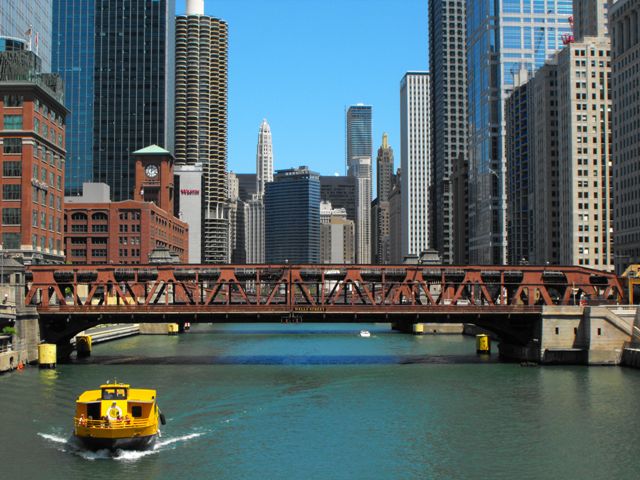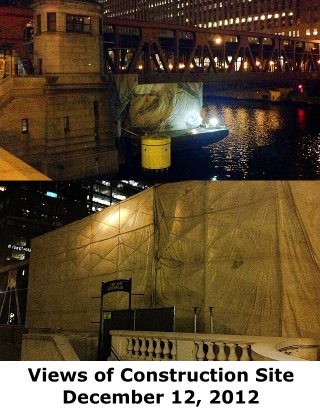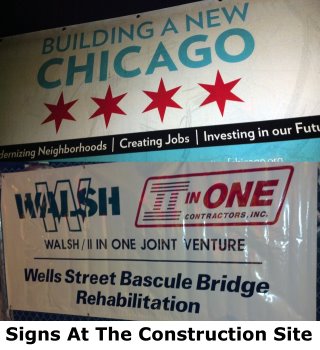We Recommend:
Bach Steel - Experts at historic truss bridge restoration.
Wells Street Bridge

Primary Photographer(s): Nathan Holth
Bridge Documented: March 26, 2006 - September 11, 2012
Wells Street and Railroad (Chicago Transit Authority "L" Brown and Purple Lines) Over Chicago River
Chicago: Cook County, Illinois: United States
Metal Rivet-Connected Warren Through Truss, Movable: Double Leaf Bascule (Fixed Trunnion) and Approach Spans: Metal Stringer (Multi-Beam), Fixed
1922 By Builder/Contractor: Ketler-Elliott Company of Chicago, Illinois and Engineer/Design: City of Chicago
2013
268.0 Feet (81.7 Meters)
345.2 Feet (105.2 Meters)
38 Feet (11.58 Meters)
1 Main Span(s) and 4 Approach Span(s)
16605404144

View Information About HSR Ratings
Bridge Documentation
Additional Information: The replica railings on this bridge were fabricated by Future Fabricating, who did a wonderful job returning original design ornamental railings to this historic bridge!
View Archived National Bridge Inventory Report - Has Additional Details and Evaluation
View Historic American Engineering Record (HAER) Documentation For This Bridge
HAER Data Pages, PDF
About This Bridge
This fixed trunnion bascule bridge and its design is one of the finest and most impressive in the city of Chicago. Along with its near-twin on Lake Street, these are the only two movable bridges along the loop that carry the CTA "L" trains. These two bridges are also the only two double-deck bridges in Chicago that carry trains on one deck and vehicular traffic on the other deck. On both, the trains travel on the upper deck, allowed the already-elevated trains to seamlessly connect to the bridge at this level, while vehicular traffic travels on the lower deck. Sidewalks are also located on the lower deck. The double-deck configuration of the Wells Street Bridge makes for a very massive bridge. Because it is so massive, this bridge is very impressive to watch being raised or lowered. The Wells Street Bridge was built after Lake Street Bridge and as such was an opportunity for the city to improve slightly on its efforts on Lake Street, but overall the appearance of the two bridges is very similar. The Wells Street Bridge is technologically significant for its double-deck design, and also for the fact that it contains the second longest clear span among the bridges along the Loop, with a clear span length of 231 Feet (70.4 Meters).

Like the Lake Street Bridge, the Wells Street Bridge was constructed while not interrupting traffic on the previous bridge, which was a swing bridge. Chicago Engineer of Bridges Thomas Pihlfeldt considered the Lake and Wells Street Bridges to be his greatest achievements, not surprising given the complexity of their design and construction.
This bridge was built in 1922 and is one of the bridges that is historically significant for being associated with the noteworthy Plan of Chicago. The superstructure for the bridge was built by Ketler and Elliot Co., and the substructure was built by Fitzsimons and Connell Dredge and Dock Co. Original electrical equipment was installed by C. H. Norwood. The Fort Pitt Bridge Company fabricated the steel for the bridge.
The Wells Street Bridge continues to serve its original purpose, carrying both vehicular traffic and frequent runs of the Chicago L, specifically CTA's Brown and Purple lines, as well as opening to allow boat traffic to pass.
Previous Bridges
The first documented bridge at this location was built in 1840-1841 as a wooden floating bridge. It was destroyed in an icy flood in 1849 along with bridges at Kinzie, Clark, and Randolph Streets. A Chicago Annual Report of the Department of Public Works states that the bridge was rebuilt in wood by a contractor named "Harper" in 1856. The bridge was again listed as rebuilt in 1862, this time with Fox and Howard listed as contractors. This bridge burned in the infamous 1871 fire. In 1872, Fox and Howard constructed an iron swing bridge at this location. In 1888, this bridge was moved to serve at Dearborn Street, allowing for a new swing bridge to be built by the Keystone Bridge Company in 1888. The 1888 bridge was converted to a double-deck bridge in 1896.
2012-2013 Comprehensive Rehabilitation Project

The Chicago Department of Transportation (CDOT) currently rehabilitating this historic bridge with on-site closures beginning in December 2012 and expected completion in November 2013. The time has come, since the bridge is in need of paint and deterioration is apparent in several areas on the bridge's trusses, and the bridge was given low structural ratings in the 2009 National Bridge Inventory (NBI). Fortunately, Chicago is a city that recognizes that low NBI ratings do not actually mean that demolition and replacement is required like many other highway agencies wrongly think. Rehabilitating the Wells Street Bridge will preserve this historic bridge, and will also save taxpayer money since rehabilitation is traditionally far less costly than demolition and replacement. Listen to a podcast interview here, courtesy of The Infrastructure Show. The proposed scope of work for rehabilitation includes:
- Rehabilitate bridge trusses with selective replacements and/or repairs
- Replace floorbeams and gusset connection plates
- Replace bottom chord.
- Replace bracing.
- Replace roadway stringers to support new grating, evaluate the use of concrete-filled on the movable spans and elimination of jack beams
- Replace sidewalk support brackets and railing.
- Current non-original railing to be replaced with a historic replica railing.
- Clean and paint structural steel and bridge machinery
- Replace all access walkways
- Repair and/or reconstruct river walls, abutments and backwalls and river dolphins
- Rehabilitate and/or replace electrical and mechanical systems
- Rehabilitate architectural elements of bridge houses including windows, doors, heating and plumbing systems, roofing and flashing, etc.
- Preparation of construction staging and traffic control
- Coordination with adjacent property owners
- Coordination with Coast Guard, Illinois Department of Natural Resources, Illinois Environmental Protection Agency and U.S. Army Corps of Engineers

Considering the above scope of work, particularly in terms of the superstructure, the 2012 rehabilitation of this bridge will be the most extensive rehabilitation project the bridge has received since it was built.
Johnny Morcos provided some additional details about the rehabilitation. Approximately, the five outermost truss panels of each leaf will be replaced entirely. However, with the exception of using bolts instead of rivets, these trusses are to replaced in kind, and historic details such as built-up beams with lattice will be replicated. The more extensive replacement of the center portions of the bridge is similar to rehabilitations elsewhere in Chicago. This is because the trusses in this part of the bridge, due to the design, are less massive and have been more susceptible to deterioration by things like winter salt, leading to more extensive section loss. Originally, the bridge got its operating power as DC current through the CTA electrical systems. During the Wacker Drive rehabilitation that occurred immediately before this rehabilitation project, the southern side was converted to AC power. Now, the north side of the bridge will also be converted to AC power. The existing motors for the bridge are expected to be rewound and reused. A couple of the bridge's existing gears will be replaced, but most will be retained.
A visit to the bridge in December 2012 revealed that the ends of the bridge have been encapsulated, likely for cleaning and painting operations. Signs at the bridge indicate that Walsh and II in One are the contractors involved with the project.
In March 2013, the replacement of the five truss panels of the southern bascule leaf took place. Similar to when the bridge was first built, great priority was placed upon minimizing bridge closure to trains. As such, the replacement truss section was fabricated off site (reportedly in the vicinity of the South Fork of the South Branch Chicago River) and floated to the bridge on barges. The old section was then cut off and replaced with the new section, limiting closure to within a week's time.
A video illustrating the rehabilitation procedure was produced by the Chicago DOT and is available at YouTube here, or an archived version is here for download. Additionally, CDOT produced a video discussing the rehabilitation and is available at YouTube here, or an archived version is here for download.
A visit on April 12, 2013 revealed that the preparation for replacing the northern leaf truss panels was well underway. The new truss panels had already been assembled and floated in on barge, which was sitting next to the Merchandise Mart. The removed section of the southern leaf had been completely dismantled and hauled away, leaving that barge open and ready to receive the section of the northern truss when it is removed. Workers were still removing things like sidewalk cantilevers and appearing the ream out rivet holes from the truss, in preparation for removing the section of the north leaf truss. On the bridge deck, numerous temporary concrete barriers were in place, which are used to keep the bridge in balance as materials are removed from the bridge, an action which would otherwise bring the counterweighted leaf into a state of imbalance, and could cause a leaf to rise in an uncontrolled manner.
A visit in August 12, 2013 found that installation of the sidewalks was underway. Some of the new sidewalk cantilevers, railing panels, and deck surface had been installed. However, many sections of the bridge did not yet have these items installed yet. The entire bridge was still painted in grey primer.
On November 21, 2013, the bridge was reopened to vehicular and pedestrian traffic.
2012: A 90th Anniversary For The Bridge
The timing of the bridge's rehabilitation, 2012, occurs in a landmark year for the bridge: February 11, 2012 marks the 90th anniversary for this bridge.
Click here to view a press release article about the anniversary from Chicago Loop Bridges.
|
Main Plaque WM. HALE THOMPSONMAYOR
HUGH E. YOUNG ENGINEER OF BRIDGE DESIGN CHICAGO PLAN COMMISSION E. H. BENNETT CONSULTING ARCHITECT CHICAGO CHAPTER OF AMERICAN INSTITUTE OF ARCHITECTS CHICAGO ART COMMISSION CONSTRUCTION
ELECTRICAL EQUIPMENT C. H. NORWOOD 1922 |
Historical Articles
View An Article About This Bridge From the Journal of the Western Society of Engineers and An Article From Successful Methods
View An Article About This Bridge From The Engineering News-Record
View A Detailed Historical Article From Engineering World With Construction Photos
View An Article From Public Works About The Bridge Substructure Construction
![]()
Historic Bridges of Chicago and Cook County


Chicago and Cook County are home to one of the largest collections of historic bridges in the country, and no other city in the world has more movable bridges. HistoricBridges.org is proud to offer the most extensive coverage of historic Chicago bridges on the Internet.
General Chicago / Cook County Bridge Resources
Chicago's Bridges - By Nathan Holth, author of HistoricBridges.org, this book provides a discussion of the history of Chicago's movable bridges, and includes a virtual tour discussing all movable bridges remaining in Chicago today. Despite this broad coverage, the book is presented in a compact format that is easy to take with you and carry around for reference on a visit to Chicago. The book includes dozens of full color photos. Only $9.95 U.S! ($11.95 Canadian). Order Now Direct From The Publisher! or order on Amazon.
Chicago River Bridges - By Patrick T. McBriarty, this is a great companion to Holth's book shown above. This much larger book offers an extremely in-depth exploration of Chicago's movable highway bridges, including many crossings that have not existed for many years. Order Now Direct From The Publisher! or order on Amazon.
View Historic American Engineering Record (HAER) Overview of Chicago Bascule Bridges (HAER Data Pages, PDF)
Chicago Loop Bridges - Chicago Loop Bridges is another website on the Internet that is a great companion to the HistoricBridges.org coverage of the 18 movable bridges within the Chicago Loop. This website includes additional information such as connections to popular culture, overview discussions and essays about Chicago's movable bridges, additional videos, and current news and events relating to the bridges.
Additional Online Articles and Resources - This page is a large gathering of interesting articles and resources that HistoricBridges.org has uncovered during research, but which were not specific to a particular bridge listing.
This bridge is tagged with the following special condition(s): Double-Deck
![]()
Photo Galleries and Videos: Wells Street Bridge
Pre-Rehab Structure Overview
Original / Full Size PhotosA collection of overview photos that show the bridge as a whole and general areas of the bridge. This large collection of photos was taken between from 2006 through 2012, prior to the major rehabilitation of this bridge. This gallery offers photos in the highest available resolution and file size in a touch-friendly popup viewer.
Alternatively, Browse Without Using Viewer
![]()
Pre-Rehab Structure Details
Original / Full Size PhotosA collection of detail photos that document the parts, construction, and condition of the bridge. This large collection of photos was taken between from 2006 through 2012, prior to the major rehabilitation of this bridge. This gallery offers photos in the highest available resolution and file size in a touch-friendly popup viewer.
Alternatively, Browse Without Using Viewer
![]()
Pre-Rehab Structure Overview
Mobile Optimized PhotosA collection of overview photos that show the bridge as a whole and general areas of the bridge. This large collection of photos was taken between from 2006 through 2012, prior to the major rehabilitation of this bridge. This gallery features data-friendly, fast-loading photos in a touch-friendly popup viewer.
Alternatively, Browse Without Using Viewer
![]()
Pre-Rehab Structure Details
Mobile Optimized PhotosA collection of detail photos that document the parts, construction, and condition of the bridge. This large collection of photos was taken between from 2006 through 2012, prior to the major rehabilitation of this bridge. This gallery features data-friendly, fast-loading photos in a touch-friendly popup viewer.
Alternatively, Browse Without Using Viewer
![]()
2013 Bridge Rehabilitation
Original / Full Size PhotosA collection of photos documenting the rehabilitation of this historic bridge. This gallery offers photos in the highest available resolution and file size in a touch-friendly popup viewer.
Alternatively, Browse Without Using Viewer
![]()
2013 Bridge Rehabilitation
Mobile Optimized PhotosA collection of photos documenting the rehabilitation of this historic bridge This gallery features data-friendly, fast-loading photos in a touch-friendly popup viewer.
Alternatively, Browse Without Using Viewer
![]()
Additional Unorganized Photos
Original / Full Size PhotosA supplemental collection of photos that are from additional visit(s) to the bridge and have not been organized or captioned. This gallery offers photos in the highest available resolution and file size in a touch-friendly popup viewer.
Alternatively, Browse Without Using Viewer
![]()
Additional Unorganized Photos
Mobile Optimized PhotosA supplemental collection of photos that are from additional visit(s) to the bridge and have not been organized or captioned. This gallery features data-friendly, fast-loading photos in a touch-friendly popup viewer.
Alternatively, Browse Without Using Viewer
![]()
Raising Bridge, Elevation
Full Motion VideoTaken June 2011. Streaming video of the bridge. Also includes a higher quality downloadable video for greater clarity or offline viewing.
![]()
CTA L Train Crossing Bridge
Full Motion VideoTaken May 2012. Streaming video of the bridge. Also includes a higher quality downloadable video for greater clarity or offline viewing.
![]()
Bridge Being Raised
Full Motion VideoStreaming video of the bridge. Also includes a higher quality downloadable video for greater clarity or offline viewing.
![]()
Maps and Links: Wells Street Bridge
Coordinates (Latitude, Longitude):
Search For Additional Bridge Listings:
Bridgehunter.com: View listed bridges within 0.5 miles (0.8 kilometers) of this bridge.
Bridgehunter.com: View listed bridges within 10 miles (16 kilometers) of this bridge.
Additional Maps:
Google Streetview (If Available)
GeoHack (Additional Links and Coordinates)
Apple Maps (Via DuckDuckGo Search)
Apple Maps (Apple devices only)
Android: Open Location In Your Map or GPS App
Flickr Gallery (Find Nearby Photos)
Wikimedia Commons (Find Nearby Photos)
Directions Via Sygic For Android
Directions Via Sygic For iOS and Android Dolphin Browser
USGS National Map (United States Only)
Historical USGS Topo Maps (United States Only)
Historic Aerials (United States Only)
CalTopo Maps (United States Only)














